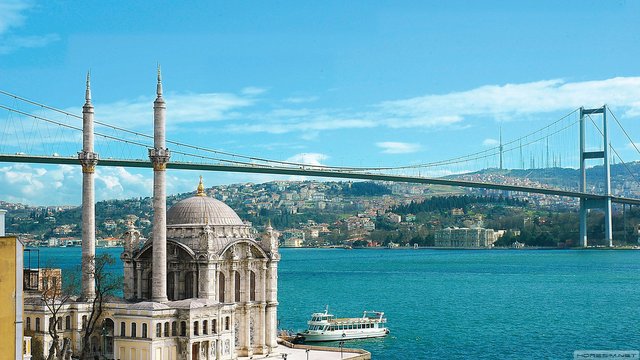
Istanbul is the largest city in Turkey and the second largest city in terms of population. It is an economic, tourist and cultural capital located in the northwestern Marmara region, historically known as Byzantium, Constantinople, Astana and Islambol.
Istanbul has been the capital of a number of countries and empires throughout its long history, owing to its central geographical position, was the capital of the Roman Empire, the Byzantine Empire, the Latin Empire and the Ottoman Empire.
Ottoman conquest The conclusion of the Middle Ages and the beginning of modern times

The Ottomans were able to jump on the territory of the Byzantine state in Anatolia, where they controlled the most important cities such as the region, Izmit, the eastern eastern gate of Constantinople, Galipoli overlooking the Dardanelles, and then they expanded west of the city in Thrace and took control of Aderna. Their wars reached Libya and Greece. The city and completely isolate it from its surroundings.
Constantinople fell on May 29, 1453, in the hands of the Ottomans, led by Sultan Mohamed II, known as Fateh after its siege for 53 days, and then complex military operations to bypass the defense lines protecting the city from land and sea.
After the Ottoman conquest, the conqueror of the Ottoman Empire was transferred from Aderna to Constantinople, which became the name of Islambol (the city of Islam) and began a new phase in the history of the city.

The fall of Constantinople is an event of great importance in world history, as it is prepared by many historians, or even most of them, until the conclusion of the Middle Ages and the beginning of modern times.
The total area of Istanbul is 5461 square kilometers, the land area of which is 5343 square kilometers, while the central city area is 1830 square kilometers. The city is administratively divided into 39 municipalities, of which 27 are the central city.
Istanbul was chosen as the European Cultural Capital of 2010, and its historical features were added in 1985 to the UNESCO World Heritage List.
Istanbul is the most important economic center in Turkey. It provides employment for 20% of Turkey's workforce, contributes 22% of Turkey's GDP, 40% of the country's total taxes and produces 55% of Turkish exports.
Sunni Muslims are the majority of its population. There are several minorities, the most important of which are the Alawite Muslims, who are the largest religious minority in Istanbul, the Greek Orthodox Christians, the Armenian Orthodox Christians, the Eastern Catholic Christians, the Latin Shomans, the Sephardic Jews and some Ashkenazic Jews.
The city is famous for its large historical mosques with prominent Ottoman features such as the Sulaymaniyah Mosque, Sheikh Zadeh Mosque, Sultan Ahmad, Al Fathah, the New Mosque, the Mosque of Abu Ayyub Al Ansari, and others.
Bosphorus Strait

The eastern part of Asia is the eastern part of the Caucasus. The western part (Chatalja peninsula) is located on the European continent east of the region of Thrace, located geographically in the south-east of the Balkans, one of the best defensive sites in the world.
15 July Martyrs' Bridge or the former Bosphorus

It is one of the three bridges linking Europe to Asia. Built in 1973, it is 1,510 meters (4,954 feet) long and has a width of 39 meters (128 feet).
The distance between the towers to 1,074 meters (3,524 feet) and the height of 105 meters (344 feet), the distance between the sea and the bridge to 64 meters (210 feet)
Sultan Mohamed El Fateh Bridge

It was opened in 1988 by Jedda, the second Bosphorus bridge. It was named after Sultan Mohamed El Fateh. Its length is 1,510 meters, and its width is 39 easier. The distance between the towers is 1,090 ta and they are 105 meters high. The distance between it and the sea reaches 64 capacity.
Aya Sofia

This building was built daily between the years 360 and 1453, excepted during the period between 1204 and 1261, when it became the work of the Latin Empire.
It was converted into a mosque from May 29, 1453, until 1934, when the Turkish constitution declared Turkey a secular state and became a museum.